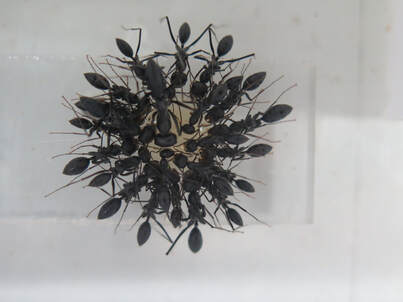Photo: Maya Saar (Cataglyphis niger in a maze)
Publications
Peer-reviewed articles
8. Sieber K, Saar M, Opachaloemphan C, Gallitto M, Yang H, Yan H (2021). Embryo injections for CRISPR-mediated mutagenesis in the ant Harpegnathos saltator. Journal of Visualised Experiments. doi: 10.3791/61930. PDF
-Video
7. Saar M, Hershkoviz D*, Amano O*, Bega D, Subach A, Scharf I (2020). The effect of food preference, landmarks, and maze shift on maze-solving time in desert ants. Behaviour. 157: 629-665. PDF
6. Bega D, Samocha Y, Yitzchak N*, Saar M, Subach A, Scharf I (2020). Non-spatial information on the presence of food elevates search intensity in ant workers, leading to faster maze solving in a process parallel to spatial learning. PLoS ONE. 15: e0229709. PDF
5. Bega D, Samocha Y, Yitzchak N*, Saar M, Subach A, Scharf I (2019). The effect of habitat complexity on maze-solving time in a desert ant. Behavioural Processes. 166: e103893. PDF
4. Saar M, Eyer PA, Kilon-Kallner T*, Hefetz A, Scharf I (2018). Within-colony genetic diversity differentially affects foraging, nest maintenance, and aggression in two species of harvester ants. Scientific Reports. 8: 13868. PDF
- Video
3. Saar M, Subach A, Reato I*, Liber T*, Pruitt JN, Scharf I (2018). Consistent differences in foraging behavior in two sympatric harvester ant species may facilitate coexistence. Current Zoology. 64: 653-661. PDF
2. Saar M, Gilad T, Kilon-Kallner* T, Rosenfeld A*, Subach A, Scharf I (2017). The interplay between maze complexity, colony size, learning and memory in ants while solving a maze: a test at the colony level. PLoS ONE. 12: e0183753. PDF
-Popular Article (Hebrew)
-Video of one run through the maze
1. Saar M**, Leniaud L**, Aron S, Hefetz A (2014). At the brink of supercoloniality: genetic, behavioral, and chemical assessments of population structure of the desert ant Cataglyphis niger. Frontiers in Ecology & Evolution. 2: 13. PDF
* denotes undergraduate students
** denotes equal contributions
Selected popular science articles (Hebrew)
16. May 2023: New extensive research uncovers the phylogeny of butterflies, where and when they originated, and their old ties to plants. Link
15. May 2023: For World Bee Day, I wrote about the bees that truly need our global and local protection (hint: not honeybees). Link
14. Sep. 2022: The potential ecological threats by the invasive dwarf honeybee (Apis florea) in Israel (advise: Prof. Sharoni Shafir, The Robert H Smith Faculty of Agriculture Food and Environment, Hebrew University). Link
13. Oct. 2021: The little fire ant (Wasmannia auropunctata) in Israel: where is it from, how does it spread and what should you do in case you encounter it? Link
12. July 2021: About a forgotten letter Albert Einstein wrote, on his thoughts on sensory research in bees & birds, and its potential contribution to human lives. Link
11. March 2021: For International Women's Day, the unconventional feminist story of one of the first documented female researchers (from the late 17th century), who happened to study insects - Maria Sibylla Merian! Link
10. Feb. 2021: Get to know Dr. Justin Schmidt, the scientist who got multiple hymenopteran stings for science (advise: Dr. Justin Schmidt, CALS, University of Arizona). Link
*Update, Feb. 2023: Sadly, we lost a pillar in entomological research, Dr. Justin Schmidt. Link
9. Dec. 2020: The weaver ant Polyrhachis lacteipennis; cleaning freaks and cowgirls. Link
8. Dec. 2020: The Mymaridae family of fairy wasps; the smallest insects in the world! Link
7. Oct. 2020: New study finds the aggregation pheromone in locust (Locusta migratoria), its molecular mechanism for absorption and target the related gene (advise: Prof. Amir Ayali, School of Zoology, Tel-Aviv University). Link
6. July 2020: What are the benefits brown bears (Ursus arctos) pursue in the famous Valley of Geysers in Kamcatka, Russia? Link
5. May 2020: New study demonstrates how harvester ants (Messor barbarus) aid in restoring a polluted environment in Spain. Link
4. Mar. 2020: A severe locust plague scorches through East Africa and Asia, and is sometimes overlooked as Covid-19 crisis grips the global attention (advise: Prof. Amir Ayali, School of Zoology, Tel-Aviv University). Link
3. Dec. 2019: Get to know BeeCSI, a new project aiming to gain understanding of dire honeybee colonies in Canada. Link
2. Oct. 2019: Mating flights of Messor harvester ants are occurring now in the Israeli skies! How, when and what is exactly going on? Link
1. Sep. 2019: Honeybees demonstrate learning of abstract concepts, better than that of human infants. Link

